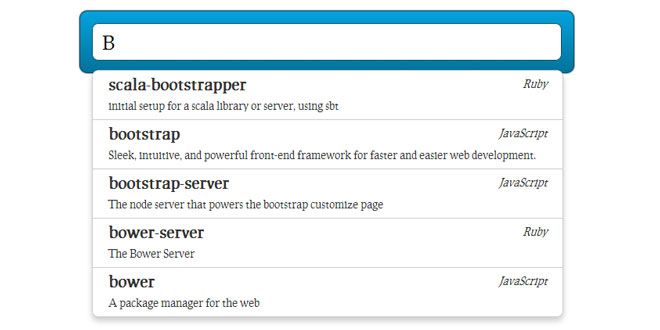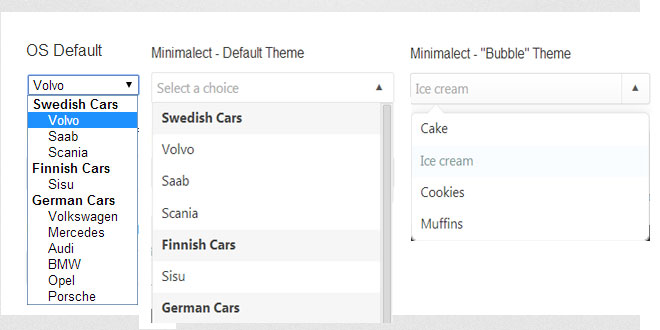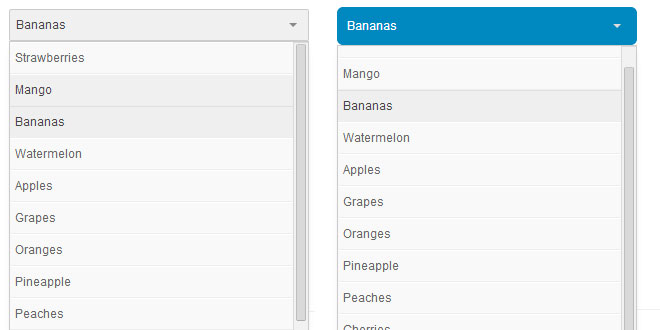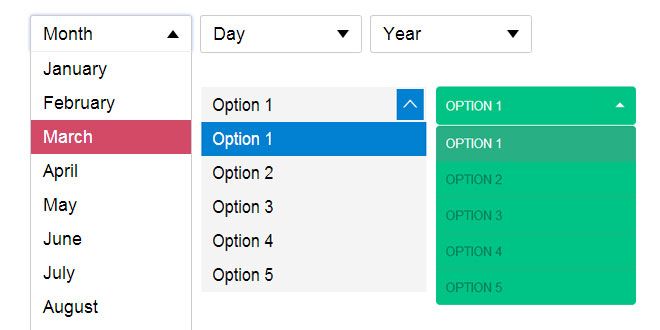- Overview
- Documents
Typeahead.js is a flexible JavaScript library that provides a strong foundation for building robust typeaheads.
Features
- Displays suggestions to end-users as they type
- Shows top suggestion as a hint (i.e. background text)
- Supports custom templates to allow for UI flexibility
- Works well with RTL languages and input method editors
- Highlights query matches within the suggestion
- Triggers custom events
The typeahead.js library consists of 2 components: the suggestion engine, Bloodhound, and the UI view,Typeahead. The suggestion engine is responsible for computing suggestions for a given query. The UI view is responsible for rendering suggestions and handling DOM interactions. Both components can be used separately, but when used together, they can provided a rich typeahead experience.
Usage
API
jQuery#typeahead(options, [*datasets])
Turns any input[type="text"] element into a typeahead. options is an options hash that's used to configure the typeahead to your liking. Refer to Options for more info regarding the available configs. Subsequent arguments (*datasets), are individual option hashes for datasets. For more details regarding datasets, refer to Datasets.
$('.typeahead').typeahead({
minLength: 3,
highlight: true,
},
{
name: 'my-dataset',
source: mySource
});
jQuery#typeahead('destroy')
Removes typeahead functionality and reverts the input element back to its original state.
$('.typeahead').typeahead('destroy');
jQuery#typeahead('open')
Opens the dropdown menu of typeahead. Note that being open does not mean that the menu is visible. The menu is only visible when it is open and has content.
$('.typeahead').typeahead('open');
jQuery#typeahead('close')
Closes the dropdown menu of typeahead.
$('.typeahead').typeahead('close');
jQuery#typeahead('val')
Returns the current value of the typeahead. The value is the text the user has entered into the input element.
var myVal = $('.typeahead').typeahead('val');
jQuery#typeahead('val', val)
Sets the value of the typeahead. This should be used in place of jQuery#val.
$('.typeahead').typeahead('val', myVal);
jQuery.fn.typeahead.noConflict()
Returns a reference to the typeahead plugin and reverts jQuery.fn.typeahead to its previous value. Can be used to avoid naming collisions.
var typeahead = jQuery.fn.typeahead.noConflict(); jQuery.fn._typeahead = typeahead;
Options
When initializing a typeahead, there are a number of options you can configure.
-
highlight – If true, when suggestions are rendered, pattern matches for the current query in text nodes will be wrapped in a strong element. Defaults to false.
-
hint – If false, the typeahead will not show a hint. Defaults to true.
-
minLength – The minimum character length needed before suggestions start getting rendered. Defaults to 1.
Datasets
A typeahead is composed of one or more datasets. When an end-user modifies the value of a typeahead, each dataset will attempt to render suggestions for the new value.
For most use cases, one dataset should suffice. It's only in the scenario where you want rendered suggestions to be grouped in the dropdown menu based on some sort of categorical relationship that you'd need to use multiple datasets. For example, on twitter.com, the search typeahead groups results into recent searches, trends, and accounts – that would be a great use case for using multiple datasets.
Datasets can be configured using the following options.
-
source – The backing data source for suggestions. Expected to be a function with the signature (query, cb). It is expected that the function will compute the suggestion set (i.e. an array of JavaScript objects) for query and then invoke cb with said set. cb can be invoked synchronously or asynchronously. A Bloodhound suggestion engine can be used here, to learn how, see Bloodhound Integration. Required.
-
name – The name of the dataset. This will be appended to tt-dataset- to form the class name of the containing DOM element. Must only consist of underscores, dashes, letters (a-z), and numbers. Defaults to a random number.
-
displayKey – For a given suggestion object, determines the string representation of it. This will be used when setting the value of the input control after a suggestion is selected. Can be either a key string or a function that transforms a suggestion object into a string. Defaults to value.
-
templates – A hash of templates to be used when rendering the dataset. Note a precompiled template is a function that takes a JavaScript object as its first argument and returns a HTML string.
-
empty – Rendered when 0 suggestions are available for the given query. Can be either a HTML string or a precompiled template. If it's a precompiled template, the passed in context will contain query.
-
footer– Rendered at the bottom of the dataset. Can be either a HTML string or a precompiled template. If it's a precompiled template, the passed in context will contain query and isEmpty.
-
header – Rendered at the top of the dataset. Can be either a HTML string or a precompiled template. If it's a precompiled template, the passed in context will contain query and isEmpty.
-
suggestion – Used to render a single suggestion. If set, this has to be a precompiled template. The associated suggestion object will serve as the context. Defaults to the value of displayKey wrapped in a p tag i.e. <p>{{value}}</p>.
-
Custom Events
The typeahead component triggers the following custom events.
-
typeahead:opened – Triggered when the dropdown menu of a typeahead is opened.
-
typeahead:closed – Triggered when the dropdown menu of a typeahead is closed.
-
typeahead:cursorchanged – Triggered when the dropdown menu cursor is moved to a different suggestion. The event handler will be invoked with 3 arguments: the jQuery event object, the suggestion object, and the name of the dataset the suggestion belongs to.
-
typeahead:selected – Triggered when a suggestion from the dropdown menu is selected. The event handler will be invoked with 3 arguments: the jQuery event object, the suggestion object, and the name of the dataset the suggestion belongs to.
-
typeahead:autocompleted – Triggered when the query is autocompleted. Autocompleted means the query was changed to the hint. The event handler will be invoked with 3 arguments: the jQuery event object, the suggestion object, and the name of the dataset the suggestion belongs to.
All custom events are triggered on the element initialized as a typeahead.
Look and Feel
Below is a faux mustache template describing the DOM structure of a typeahead dropdown menu. Keep in mind that header, footer, suggestion, and empty come from the provided templates detailed here.
<span class="tt-dropdown-menu">
{{#datasets}}
<div class="tt-dataset-{{name}}">
{{{header}}}
<span class="tt-suggestions">
{{#suggestions}}
<div class="tt-suggestion">{{{suggestion}}}</div>
{{/suggestions}}
{{^suggestions}}
{{{empty}}}
{{/suggestions}}
</span>
{{{footer}}}
</div>
{{/datasets}}
</span>
When an end-user mouses or keys over a .tt-suggestion, the class tt-cursor will be added to it. You can use this class as a hook for styling the "under cursor" state of suggestions.
Bloodhound Integration
Because datasets expect their source to be a function, you cannot directly pass a Bloodhound suggestion engine in as source. Rather, you'll need to pass the suggestion engine's typeahead adapter:
var engine = new Bloodhound({ /* options */ });
engine.initialize();
$('.typeahead').typeahead(null, {
source: engine.ttAdapter()
});
 JS Tutorial
JS Tutorial




